|
|
|
Sort Order |
|
|
|
Items / Page
|
|
|
|
|
|
|
| Srl | Item |
| 1 |
ID:
126305
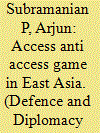

|
|
|
|
|
| Summary/Abstract |
The East Asian theatre is emerging as a region where there are frequent military confrontations. The territorial disputes are the pivot of all recent tensions in the region. China, backed by its increasing economic and military might, is turning more assertive in its claims. The dispute might be regional but any military flare up has few changes of being limited to the regional players. This is because of the security architecture in the region, in which the United States in an important external actor. This is a cause of major concern for China, particularly in the event of a possible non-pacific reunification of Taiwan with the Chinese Mainland or a war with Japan over the island dispute. At present, the US is the only power that could challenge the Chinese military supremacy in the region. Back in the 1996 Taiwan Crisis, the US had deployed two of its aircraft carriers as a signal to China of its resolve to maintain the status quo in the region. Ever since, China began to develop an Anti-Access and Area Denial (A2/ AD) strategy with the sole aim of preventing the US military from intervening in any conflict in the region involving China. This paper looks at the Chinese and US military Strategies that are involving in the region. Specific focus in given to the people`s Liberation Army Air Force bomber Aircraft force which has been modified to fire long range Air Launched Cruise Missile (ALCMs) to threaten the US military bases around China, and the future measures that the PLA might take to deny access to US forces in the region.
|
|
|
|
|
|
|
|
|
|
|
|
|
|
|
|
| 2 |
ID:
105543


|
|
|
| 3 |
ID:
193065


|
|
|
|
|
| Summary/Abstract |
The two decades of war in Afghanistan left a mark on the American armed forces and redefined the American ways of war-making. One of this war’s legacies is the reimagining of the role of private military and security contractors in contemporary warfare. Due to the massive involvement of the private sector in the American war machine, this industry transformed from a marginal participant into a central partner. The privatization of military and security functions became a norm, an integral part of security architecture and military operation. In this study, I provide a brief review of this development and its implications.
|
|
|
|
|
|
|
|
|
|
|
|
|
|
|
|
| 4 |
ID:
114985
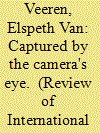

|
|
|
|
|
| Publication |
2011.
|
| Summary/Abstract |
In January 2002, images of the detention of prisoners held at US Naval Station Guantanamo Bay as part of the Global War on Terrorism were released by the US Department of Defense, a public relations move that Secretary of Defense Donald Rumsfeld later referred to as 'probably unfortunate'. These images, widely reproduced in the media, quickly came to symbolise the facility and the practices at work there. Nine years on, the images of orange-clad 'detainees' - the 'orange series' - remain a powerful symbol of US military practices and play a significant role in the resistance to the site. However, as the site has evolved, so too has its visual representation. Official images of these new facilities not only document this evolution but work to constitute, through a careful (re)framing (literal and figurative), a new (re)presentation of the site, and therefore the identities of those involved. The new series of images not only (re)inscribes the identities of detainees as dangerous but, more importantly, work to constitute the US State as humane and modern. These images are part of a broader effort by the US administration to resituate its image, and remind us, as IR scholars, to look at the diverse set of practices (beyond simply spoken language) to understand the complexity of international politics.
|
|
|
|
|
|
|
|
|
|
|
|
|
|
|
|
| 5 |
ID:
129353
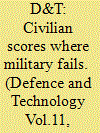

|
|
|
|
|
| Publication |
2012.
|
| Summary/Abstract |
In the last two decades, the US military has found it increasingly difficult to design and build equipment and weapons specifically for military use. There are too few manufacturers of such gear and the commercial sector is increasingly coming up with cheaper and more capable (of at least as capable) alternatives.
|
|
|
|
|
|
|
|
|
|
|
|
|
|
|
|
| 6 |
ID:
184199
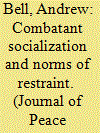

|
|
|
|
|
| Summary/Abstract |
Can armed groups socialize combatants to norms of restraint – in essence, train soldiers to adopt norms of international humanitarian law on the battlefield? How can social scientists accurately measure such socialization? Despite being the central focus of organizational and ideational theories of conflict, studies to date have not engaged in systematic, survey-based examination of this central socialization mechanism theorized to influence military conduct.
This study advances scholarly understanding by providing the first comparative, survey-based examination of combatant socialization to norms of restraint, using surveys and interviews with US Army cadets at the US Military Academy (USMA), Army Reserve Officer Training Corps (ROTC), and active duty Army combatants. Additionally, to better understand ‘restraint’ from combatants’ perspective, this study introduces the concept of the ‘combatant’s trilemma’ under which combatants conceptualize civilian protection as part of a costly trade-off with the values of military advantage and force protection.
Survey results hold both positive and negative implications for socialization to law of war norms: military socialization can shift combatants’ preferences for battlefield conduct. However, intensive norm socialization may be required to shift combatants’ preferences from force protection to civilian protection norms. Study findings hold significant implications for understanding violence against civilians in conflict and for policies to disseminate civilian protection norms in armed groups worldwide.
|
|
|
|
|
|
|
|
|
|
|
|
|
|
|
|
| 7 |
ID:
123169
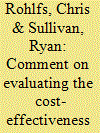

|
|
|
|
|
| Publication |
2013.
|
| Summary/Abstract |
This comment discusses the pros and cons of the methodology and data used in our previous study on the cost-effectiveness of armor on Tactical Wheeled Vehicles (TWVs), and responds to recent critiques by Franz Gayl. In our previous article, we evaluated the large-scale Army policies to replace relatively light Type 1 Tactical Wheeled Vehicles (TWVs) with moderately protected Type 2 variants, and later to replace Type 2s with heavily protected Type 3s. We find that the switch from Type 2 to Type 3 TWVs did not appreciably reduce fatalities and were not cost-effective. Mr. Gayl contends that the data and choice of control variables used in our original study negatively bias our findings for Type 3 TWVs. We defend our previous conclusions and argue that Gayl's suggested approach of focusing on deaths per insurgent attack fails to account for effects of the vehicles on when, where, and how attacks occurred. Our methodology does not suffer from this bias and measures effects on total unit casualties rather those incurred per attack. We explain that our estimates are stable across many specifications and are not sensitive to the choice of controls as Gayl suggests.
|
|
|
|
|
|
|
|
|
|
|
|
|
|
|
|
| 8 |
ID:
084600
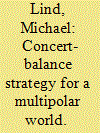

|
|
|
| 9 |
ID:
121745
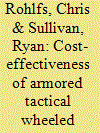

|
|
|
|
|
| Publication |
2013.
|
| Summary/Abstract |
This study uses for official use only data on US military operations to evaluate the large-scale Army policies to replace relatively light Type 1 tactical wheeled vehicles (TWVs) with more heavily protected Type 2 variants and later to replace Type 2s with more heavily protected Type 3s. We find that Type 2 TWVs reduced fatalities at $1.1 million-$24.6 million per life saved for infantry units, with our preferred cost estimates falling below the $7.5?million cost-effectiveness threshold, and did not reduce fatalities for administrative and support units. We find that replacing Type 2 with Type 3 TWVs did not appreciably reduce fatalities and was not cost-effective.
|
|
|
|
|
|
|
|
|
|
|
|
|
|
|
|
| 10 |
ID:
134403


|
|
|
|
|
| Summary/Abstract |
The twenty-first century has seen a continued evolution of the US military’s strategic interest in socio-cultural knowledge of (potential) adversaries for counterinsurgency strategies. This paper explores the implications of the reinvigorated and expanding (post-9/11) relationship between social science research and US military strategy, assessing the implications of US Africa Command strategies for preventive counterinsurgency. Preventative counterinsurgency measures are ‘Phase Zero’ or ‘contingency’ operations that seek to prevent possible outcomes, namely threats to ‘security’ in Africa. The research initiatives of US Africa Command illustrate a culture-centric approach to this strategy, which seeks to draw from detailed socio-cultural knowledge in the prevention of possible populist or popular uprisings. Recent such uprisings, resistance actions and strikes in the continent illustrate a problematic tendency to interpret various forms of populist resistance as ‘terrorist’ actions, thereby condoning the bolstering of African national military capacity. The article considers the implications of these culture-centric counterinsurgency strategies as a means of anticipating and repressing the variety of mobilisations encapsulated within the ‘terrorism’ catchall. We conclude by urging social scientists to reject and disconnect from US Africa Command’s missions and knowledge acquisition efforts in Africa.
|
|
|
|
|
|
|
|
|
|
|
|
|
|
|
|
| 11 |
ID:
110565
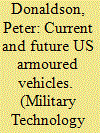

|
|
|
| 12 |
ID:
111244


|
|
|
|
|
| Publication |
2011.
|
| Summary/Abstract |
Misleading propaganda and the creation of false history were pervasive and corrosive during the Balkan wars of the 1990s. Both the Clinton administration and the news media were responsible for the disreputable situation. And unlike the discrediting of the Bush administration's distorted accounts regarding the Iraq crisis, the Balkan myths are as prevalent today as when they were first created. That situation is dangerous on two counts. First, it inhibits the formulation of intelligent, realistic, and equitable policies regarding current Balkan issues. Second, the success of such a campaign of disinformation creates the irresistible temptation for officials and policy lobbies to try the same techniques during future international crises in that region or elsewhere.
|
|
|
|
|
|
|
|
|
|
|
|
|
|
|
|
| 13 |
ID:
146212
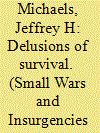

|
|
|
|
|
| Summary/Abstract |
When North Vietnam launched a military offensive in March 1975, there was little expectation that South Vietnam would collapse 55 days later. As the South’s forces quickly crumbled and the scale of the military disaster became increasingly apparent, the United States considered a number of options to provide emergency assistance to its ally. This article will examine the evolution of the diplomatic, economic, military, and covert options US policymakers developed to support the South during the Final Offensive. These policy options will be set against the backdrop of the ‘scripts’ US officials devised to justify emergency assistance, as well as their delusions about the South’s prospects for survival.
|
|
|
|
|
|
|
|
|
|
|
|
|
|
|
|
| 14 |
ID:
114131
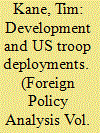

|
|
|
|
|
| Publication |
2012.
|
| Summary/Abstract |
For over six decades, the US military has shaped international economic development, notably by way of nearly 31 million US troop-year deployments since 1950. Worldwide, life expectancy increased by 10 years between 1970 and the present. The mortality rate of children dropped from 132 per 1,000 live births to 55. The number of telephone lines per capita quadrupled from 48 to 196 per thousand. In each case, the improvement was faster in countries with a heavy US troop presence and slower in countries with zero US troop presence. These relationships stem from a data set on US deployments across all countries and years from 1950 to the present matched with World Bank data on indicators of social well-being since 1970 across 148 countries. The positive relationship between American forces and social development holds in econometric regressions even when controlling for initial income levels and initial social indicator levels.
|
|
|
|
|
|
|
|
|
|
|
|
|
|
|
|
| 15 |
ID:
179505
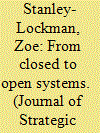

|
|
|
|
|
| Summary/Abstract |
The return to strategic competition affects the US military services differently, but all are contending with the challenge of renewing their military advantage against near-peer, technologically advanced competitors. Commercially driven innovation trends simultaneously challenge the way that the US military manages technology. This article traces the pursuits to institutionalise open innovation practices inside the services to incorporate emerging technologies into their envisaged competitive advantage. Rather than treating the US military as a monolithic entity, this article assesses how new service-level organisations differ in the ways and means they pursue innovation and seeks to explain why those differences persist.
|
|
|
|
|
|
|
|
|
|
|
|
|
|
|
|
| 16 |
ID:
116790
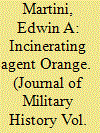

|
|
|
|
|
| Publication |
2012.
|
| Summary/Abstract |
Most studies of the herbicide Agent Orange focus on its use in the Vietnam War or its long-term consequences. Lost is the story of the 2.4 million gallons of Agent Orange still in the U.S. military's possession after its use was banned in 1971. The U.S. Air Force addressed this surplus supply during Operations Pacer IVY and Pacer HO, navigating challenges ranging from the growing environmental movement to new government bureaucracies devoted to environmental protection. This essay seeks to help fill a gap in Agent Orange scholarship and add to the literature on the intersections of military and environmental history.
|
|
|
|
|
|
|
|
|
|
|
|
|
|
|
|
| 17 |
ID:
160945
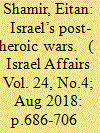

|
|
|
|
|
| Summary/Abstract |
This article examines the role of American military influence on Israel’s transition to post-heroic warfare. The main factors identified in the existing literature that have been identified to explain Israel’s transition to post-heroic warfare had to do with the changes in Israel’s strategic environment, changes in society and development of new military technology. This article sheds light on an intervening factor that further enables and shapes the transition to post-heroic war; the American military influence over the Israel Defence Forces. The strategic uncertainty and lack of professional direction encouraged Israel’s military establishment to turn to American military ideas. The US military is perceived by the IDF as a leading professional institution that is dealing with similar challenges and operating under similar constraints.
|
|
|
|
|
|
|
|
|
|
|
|
|
|
|
|
| 18 |
ID:
115502
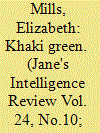

|
|
|
| 19 |
ID:
091959
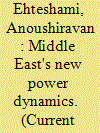

|
|
|
|
|
| Publication |
2009.
|
| Summary/Abstract |
Relations among the regional powers in the Middle East continue to dominate global conerns about security. As we watch the era of George W. Bush fade into history, we are still saddled with the consequences of politics that unleashed US military might in the region and, in the process, caused substanial imbalances among the regional powers that have proved difficult to redress.
|
|
|
|
|
|
|
|
|
|
|
|
|
|
|
|
| 20 |
ID:
114593
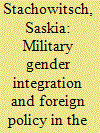

|
|
|
|
|
| Publication |
2012.
|
| Summary/Abstract |
The article investigates the relevance of foreign policy discourse and practice for military gender relations. The link between women's status in military institutions and the gendering of foreign policy has so far not been thoroughly addressed in military and gender research or foreign policy analysis. Feminist international relations provides a research strategy to show how foreign policy doctrines and debates are gendered and how they are connected to gender (in)equality in central state institutions such as the military. The article thus applies feminist international relations as a theoretical framework that transcends the constructed dichotomy between national and international levels of analysis. In a case study of the USA from the Clinton to the Obama administrations, patterns of military gender integration are established as a phenomenon incorporating both domestic and international dimensions. Foreign policy discourses and practices in this time period are related to shifts in military gender policies and discourses on gender integration. It is argued that the gender order in military institutions is linked to international politics and state behaviour in the international arena.
|
|
|
|
|
|
|
|
|
|
|
|
|
|
|
|
|
|
|
|
|